When you buy products via links on our website, we might receive an affiliate commission. Learn more
31 Creative Flower Garden Ideas to Transform Your Outdoor Space
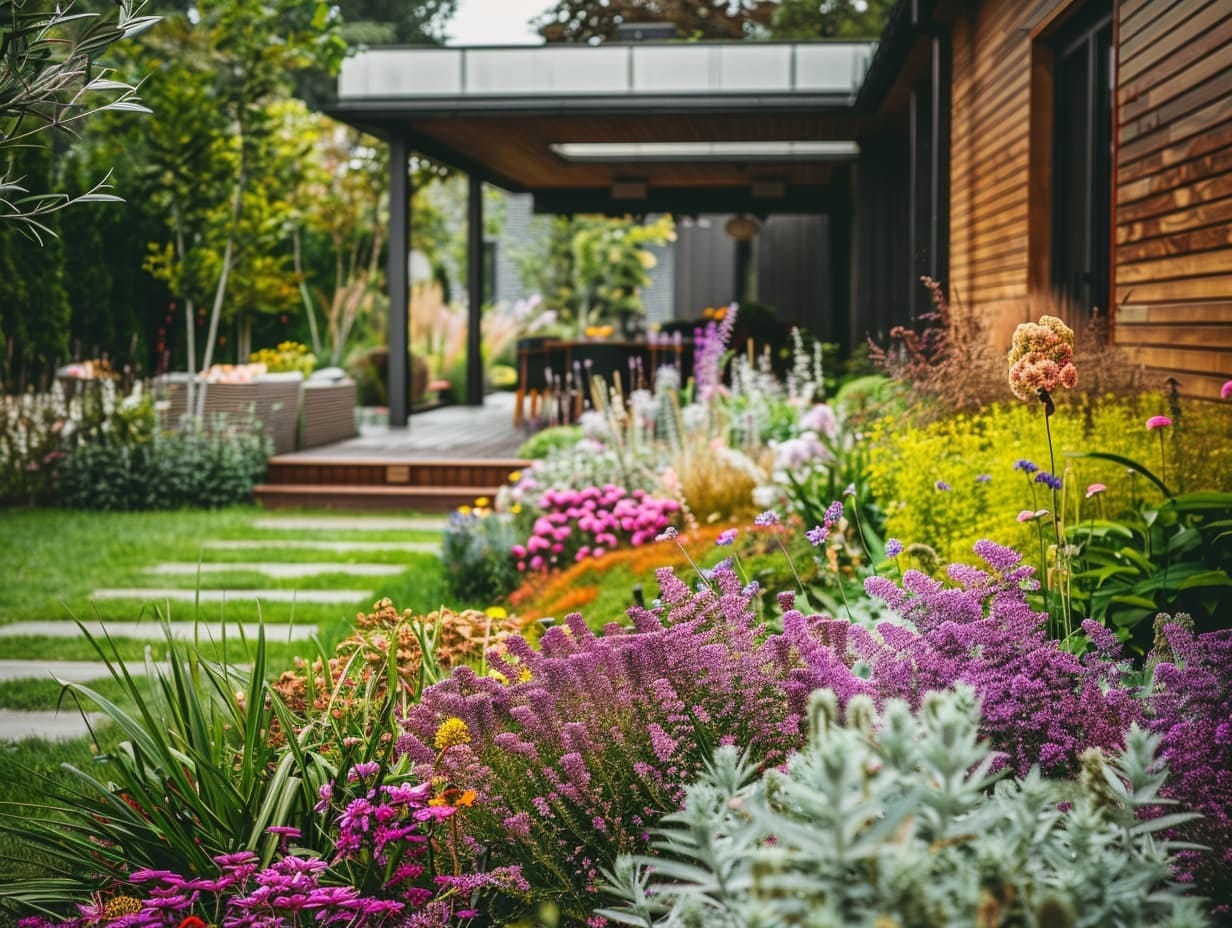
Discover a world of color and creativity with our top 31 flower garden ideas. In this guide, we explore a variety of gardening strategies designed to enhance any outdoor area, regardless of its size. From lush vertical gardens adorned with roses and vines to practical container gardening tips for small spaces, we cover a broad spectrum of options.
Explore how to design a color-themed garden that complements your home's exterior, or attract beneficial pollinators with a garden full of native blooms.
Whether you're planning a moonlight garden that shines under the stars or aiming to integrate symmetrical, geometric flower beds for a structured look, our ideas are designed to inspire gardeners of all skill levels to create a more beautiful and enjoyable outdoor space.
Design a Color-Themed Flower Garden

Creating a color-themed flower garden is an effective way to produce visual impact and cohesion in your outdoor space.
Choose a palette that complements your home’s exterior or reflects your personal style — whether it's calming pastels, vibrant hues, or sophisticated monochromes.
For instance, a monochromatic theme using various shades of purple can include lilacs, lavender, and purple tulips, providing depth and interest.
Plant in groups to intensify the color impact and consider seasonal blooms to maintain year-round appeal. Incorporate foliage with similar or contrasting colors to add texture and enhance the overall design.
Build Vertical Gardens With Roses and Climbing Vines
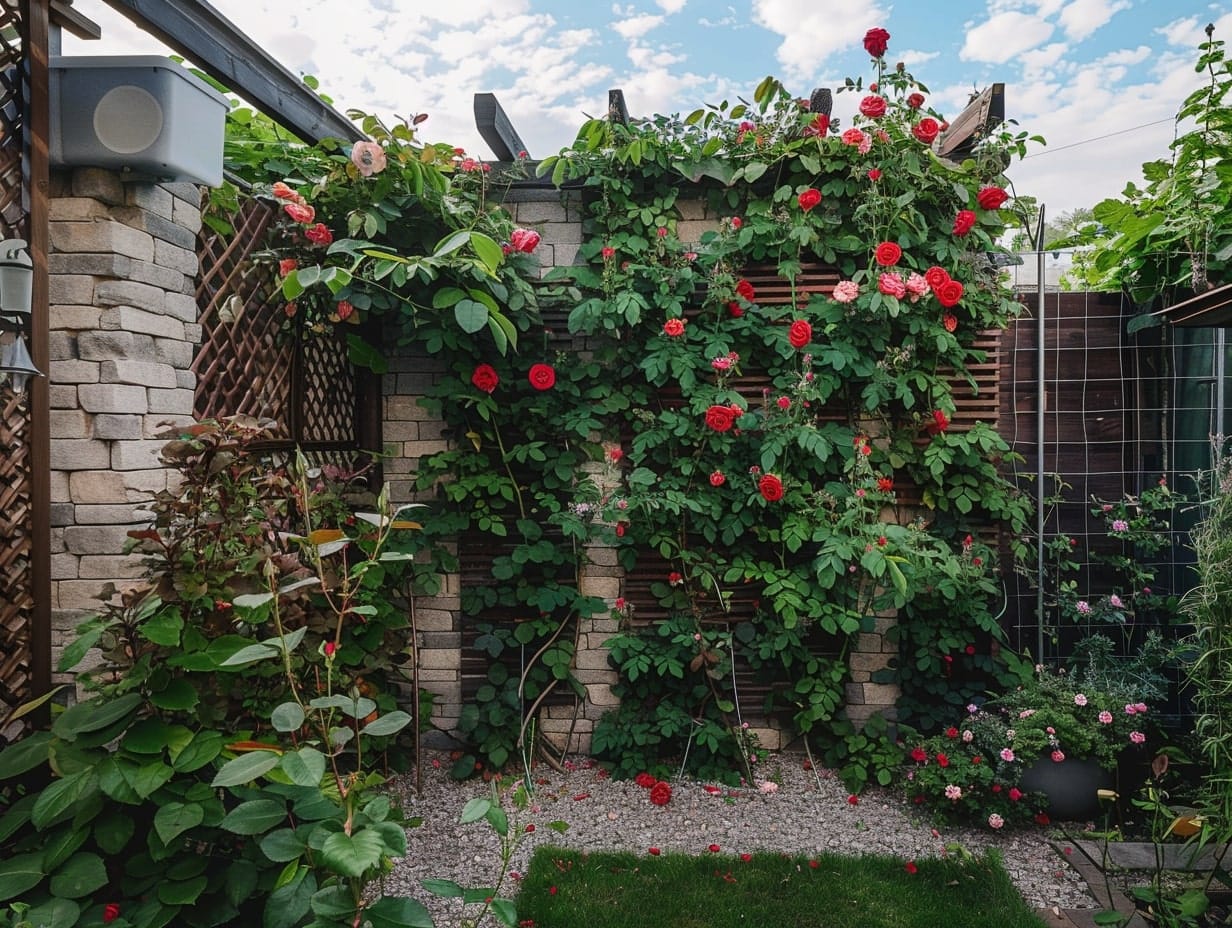
Climbing roses and vines are ideal for creating lush, upward growth, transforming plain walls, trellises, or arbors into vibrant living walls.
Start by selecting a sturdy support structure like a trellis, pergola, or wire frame that can handle the weight of mature plants. Choose climbing rose varieties that suit your climate and have the growth habits and colors that align with your design vision.
Intersperse these with fast-growing vines such as clematis or jasmine, which can provide contrasting foliage and additional blooms. Ensure the soil is well-drained and nutrient-rich to support healthy growth.
Use Pots and Containers to Grow Flowers

This method is particularly beneficial for those with limited space, such as apartment balconies, patios, or small yards.
Choose containers that complement the exterior decor and are large enough to accommodate the root growth of the plants you wish to grow. Mix different sizes and heights of containers to add depth and interest to your arrangement.
Consider planting a variety of flowers that offer different blooming schedules to maintain a colorful display throughout the season. Regularly feed and water your potted flowers to keep them vibrant and healthy.
Create a Pollinator-Friendly Garden

Designing a pollinator-friendly garden is a delightful way to support local wildlife and contribute to the health of bees, butterflies, and other pollinating insects.
Start by selecting a variety of plants that bloom at different times of the year to provide a consistent source of nectar and pollen. Include native plants which are often more attractive to local pollinators and better adapted to your regional climate.
Flowers like lavender, bee balm, sunflowers, and zinnias are excellent choices. Arrange these plants in clusters to make it easier for pollinators to locate their food sources. Consider adding features like a shallow water dish, which can serve as a drinking spot for bees and butterflies.
Design a Moonlight Garden With White and Light-Colored Flowers

A moonlight garden is designed to be enjoyed by the light of the moon, featuring plants with white and light-colored blooms and foliage that glow under moonlight. To create this enchanting nighttime garden, select flowers such as white roses, gardenias, and moonflowers that open and release their fragrance in the evening.
Integrate plants with silvery or variegated foliage like lamb's ear or dusty miller to enhance the luminous effect. Plan your layout so that these plants are visible from key viewing areas, such as a patio or bedroom window.
Add landscape lighting with a soft, white glow to simulate moonlight and extend viewing times. You can also build a reflective surface, such as a small pond or white stones, to amplify the light and add to the magical atmosphere.
Decorate the Garden Floor With Shade-Tolerant Flowers Under Trees
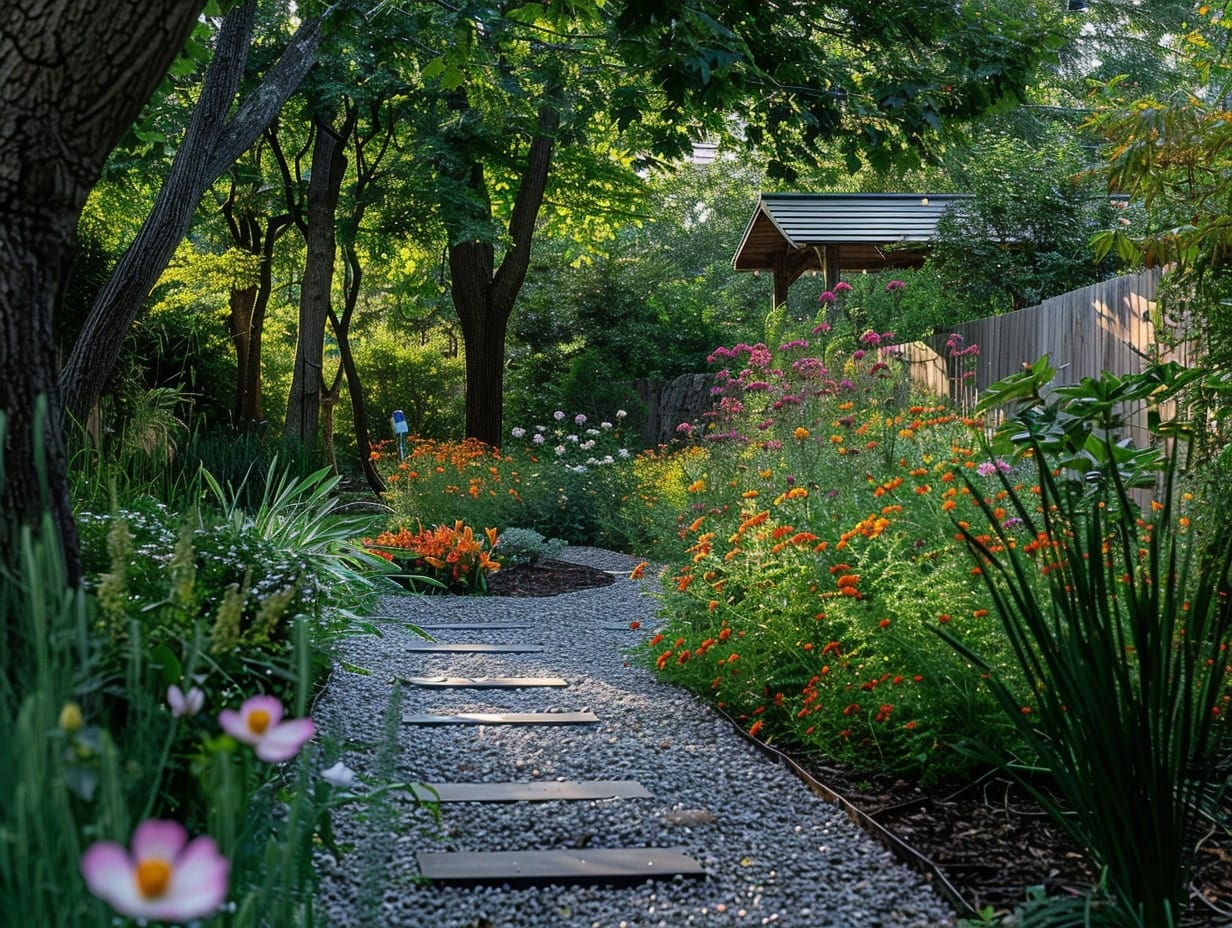
Select shade-tolerant flowers that thrive with limited sunlight. Hostas, astilbes, and ferns are excellent choices, offering a variety of textures and colors. For seasonal color, consider adding bleeding hearts or hellebores, which bloom beautifully in low-light conditions.
Incorporate different heights and blooms to create a layered effect, and use mulch to help retain soil moisture and suppress weeds, which is particularly important in shaded areas.
Create Symmetrical Designs With Geometric Flower Beds

Symmetrical and geometric designs in a garden create a sense of balance and formal beauty, ideal for structured landscapes.
To implement this, first choose a central point in your garden, such as a fountain, sculpture, or a particularly striking tree. From this central point, design mirror-image flower beds on either side to achieve symmetry.
Opt for geometric shapes like circles, squares, or triangles for the flower beds. Uniformly plant flowers of similar heights and colors in each corresponding bed to maintain the symmetry.
Popular choices for a formal garden include neatly trimmed boxwoods, vibrant tulips, or uniform rows of roses. Incorporate pathways that complement the geometric patterns, enhancing the formal look.
Sow Native Wildflowers for a Low-Maintenance Garden
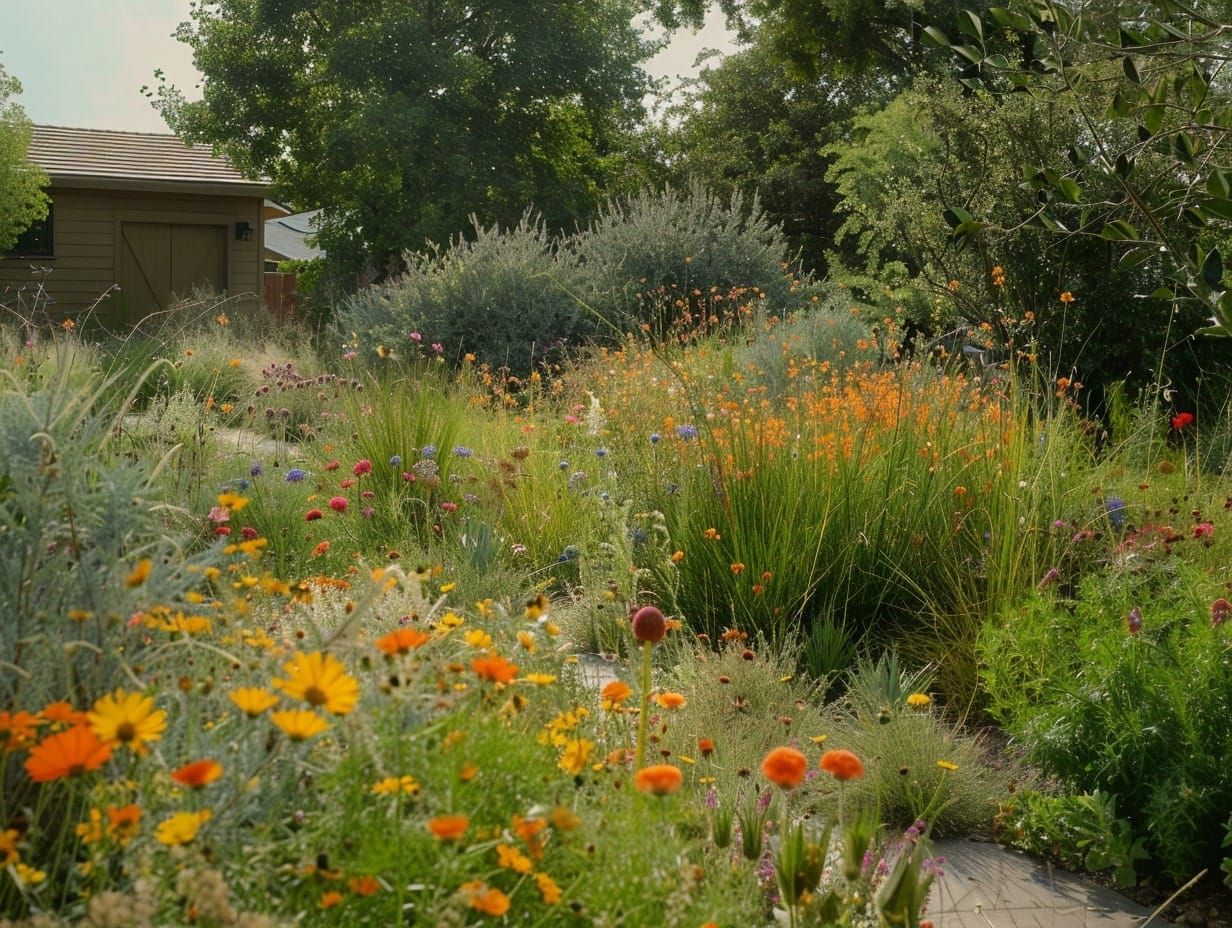
Native plants are well-adapted to local climate conditions and soil types, requiring less water, fertilizer, and pest control than non-native species.
Start by selecting a mix of wildflower seeds that are indigenous to your region, which will help support local wildlife, including pollinators like bees and butterflies.
Prepare your garden bed by removing weeds and lightly tilling the soil to give seeds a good bed to establish in. Sow the seeds evenly and at the recommended depth on the seed packet. Early spring or late fall are typically the best times to sow, depending on your local climate.
Design Separate Areas for Spring, Summer, Fall and Winter Blooms
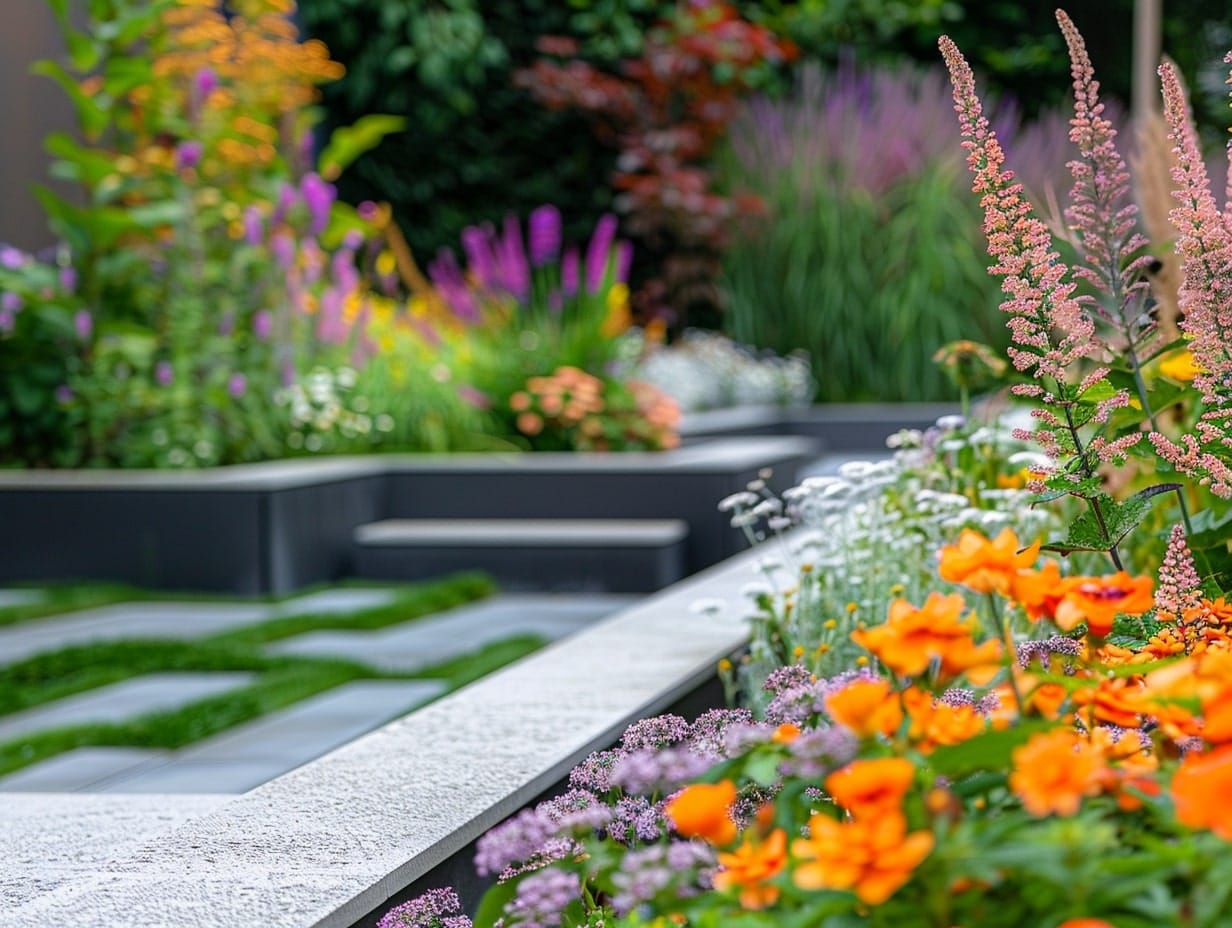
Creating distinct garden areas dedicated to each season can ensure year-round color and interest in your landscape. To implement this, divide your garden space into four sections, each tailored to the specific plants that thrive and bloom in one of the seasons.
Create a spring garden by planting early bloomers like tulips, daffodils, and hyacinths. Incorporate flowering trees such as cherry blossoms or crabapples for added drama.
For a summer garden, focus on heat-tolerant, vibrant flowers such as daylilies, coneflowers, and zinnias. Add some perennial herbs like lavender and rosemary that peak in summer’s heat.
To create a fall garden, choose plants with late blooms and colorful foliage. Chrysanthemums, asters, and sedum are great for flowers, while maples and burning bushes provide spectacular foliage.
To design a winter garden, opt for plants that offer visual interest in winter, such as evergreens or those with colorful berries and textured bark. Holly bushes and winter jasmine can brighten the darker days.
Plant a Flower Garden on Your Rooftop

Before beginning, ensure that your roof can support the weight of soil, plants, and furniture. Consult a structural engineer if necessary.
Use lightweight containers with good drainage. Raised beds can also be a practical option if additional weight support is available. Materials like fiberglass or foam composites are ideal as they are lighter and weather-resistant.
Opt for plants that can withstand potentially harsh rooftop conditions, such as strong winds and high exposure to sun. Hardy perennials, small shrubs, succulents, and grasses typically do well. Consider the microclimate of your rooftop when selecting plants.
Line Walkways With Low-Growing Flowers for a Picturesque Path

Opt for low-growing, hardy plants that can tolerate foot traffic if they stray off the path. Ground covers like creeping thyme, sedum, or dwarf mondo grass are excellent choices. For a bit more height, consider using annuals like lobelia or perennials like ajuga, which provide vibrant color and texture.
Before planting, ensure that the soil along the walkway is well-drained and fertile. Amend the soil with compost to provide nutrients needed for the plants to thrive. Plant the flowers close enough to ensure they will grow together and form a dense mat. This not only looks lush and full but also helps suppress weed growth.
Use edging materials like stone, brick, or metal to clearly define the boundary between the walkway and the flower bed. This keeps the walkway neat and prevents the plants from spreading onto the path.
Decorate Your Yard With Hanging Baskets Filled With Flowers

Hanging baskets are a wonderful way to add vertical interest and vibrant splashes of color to your yard, making use of airspace that would otherwise go unnoticed.
Select baskets that are large enough to give your plants room to grow and thrive. Materials like coir or moss-lined wire baskets not only look beautiful but also help retain moisture, which is crucial for hanging plants.
Choose a mix of trailing and blooming plants that suit the amount of sunlight your yard receives. Petunias, verbena, and fuchsias are excellent for sunny spots, while impatiens and ferns might be better suited for shaded areas. Incorporate a variety of colors and textures to create visually appealing arrangements.
Hang your baskets at different heights to create a tiered effect, and place them in areas where they can be best appreciated, such as along walkways, from tree branches, or on porches.
Create a Wheelbarrow Flower Garden for a Rustic Touch

An old, weathered wheelbarrow is ideal for this project as it adds character and a sense of history. Ensure it's still sturdy enough to hold soil and plants.
Drill drainage holes in the bottom of the wheelbarrow if there aren’t any to ensure excess water can escape, preventing root rot. Clean the interior and remove any rust spots to prevent further deterioration.
Select plants that complement each other in height, color, and blooming period to ensure continuous visual interest.
For a full, lush look, combine upright, trailing, and filler plants. For instance, petunias or pansies for color, ivy or sweet potato vines for spill-over, and taller flowers like snapdragons for height.
Place the wheelbarrow in a spot that suits the light requirements of the plants you’ve chosen.
Create a Magical Mini Flower Garden With Fairy Decorations

Designing a magical mini flower garden enhanced with fairy decorations is a delightful way to engage the imagination and add whimsy to your outdoor space. This type of garden is particularly appealing to children but can enchant visitors of all ages.
Select a small, quiet corner of your garden that can be dedicated to this miniature world. Ensure it is somewhat sheltered, to protect the delicate decorations and plants from harsh elements.
Choose small-scale plants and flowers that lend themselves to a fairy landscape. Miniature ferns, mosses, and ground covers like baby's tears create a lush, green base. Tiny flowering plants such as violas, miniature daisies, and thyme add color and texture.
Add small stones to create pathways, use twigs to make tiny fences or arbors, and include natural wood slices for a rustic touch. Introduce fairy houses, miniature furniture, and figurines.
Focus on Long-Lasting Perennials for Continuous Blooms

Choose perennials that bloom at different times throughout the growing season to ensure continuous color. For instance, combine early bloomers like peonies or lupines with mid-season flowers such as echinacea or daylilies, and late bloomers like asters or rudbeckia.
Some perennials, like coreopsis and salvia, offer extended bloom periods, which can keep your garden lively for much of the season. Others, like hostas and sedum, provide attractive foliage after their blooms have faded.
Arrange plants so that as one perennial starts to fade, another begins to peak. This staggered approach ensures that your garden remains vibrant and dynamic.
Plant Annuals That Provide Bright Colors for One Season

Annuals are a fantastic choice for gardeners looking to inject vibrant, seasonal color into their landscapes.
Decide on a color palette that complements the overall design of your garden. Annuals come in a wide range of colors, so whether you want bright, bold hues like marigolds and zinnias or softer tones like pansies and petunias, there’s an abundance of choices.
Pay attention to the growth habits of the annuals you select. Some, like snapdragons and cosmos, grow tall and can be used as background plants, while others like impatiens and begonias stay low and dense, perfect for borders or underplanting.
To maintain continuous color and coverage, practice succession planting. This involves staggering the planting of your annuals throughout the growing season so that new blooms are ready to take over as earlier plants begin to fade.
Grow Flowers With Medicinal Properties Like Chamomile and Lavender

Both chamomile and lavender thrive in full sun and well-drained soil. Lavender, in particular, prefers slightly alkaline conditions, so consider adding a bit of lime to the soil if it’s too acidic.
While chamomile is adaptable to various soil types, ensuring the soil is loose and fertile will promote healthier growth. Lavender requires loose, well-draining soil to prevent root rot. Adding sand or gravel can improve drainage, essential for lavender’s success.
You can start chamomile and lavender from seeds or purchase young plants from a nursery. For seeds, sow them directly into the garden in early spring. Lavender seeds can be slow to germinate and may do better started indoors and transplanted as seedlings.
Pick chamomile flowers when fully open, typically in the morning after the dew has dried. Lavender is best harvested just as the buds begin to open, which is when the essential oils are most concentrated.
Create a Beautiful Rose Garden With Different Varieties of Roses

Roses look best when planted in groups or rows, which can highlight their colors and forms. Traditional formal designs often feature symmetrical patterns, while a more casual cottage-style garden might mix roses with other plants.
Choose a mix of rose types to extend blooming times and add interest. Include hybrid teas for their classic form, floribundas for continuous blooms, climbing roses for vertical interest, and shrub roses for their robust nature and disease resistance.
Consider different fragrances, colors, and bloom shapes to add diversity. Select rose varieties that are well-suited to your local climate. Consider factors like sunlight, as roses generally need about six hours of direct sun per day, and soil conditions. Roses prefer rich, well-draining soil with a slightly acidic to neutral pH.
Emulate a Prairie With Tall Grass and Native Flowers

Creating a prairie-style garden is a wonderful way to incorporate the beauty and ecological benefits of a natural grassland into your landscape.
Prairie gardens do best in open, sunny areas. The plants typically require a lot of light to thrive, so choose a spot that receives at least six hours of direct sunlight daily.
Choose a mix of native grasses and wildflowers that are adapted to your region. Typical prairie grasses include big bluestem, switchgrass, and Indian grass. Complement these with wildflowers like coneflowers, black-eyed Susans, and milkweed to add color and support local pollinators.
Use a higher ratio of grasses to flowers—about two-thirds grasses to one-third flowers is typical in many natural prairies.
Plant Flowers Around a Garden Pond to Add Fragrance and Reflection

Create a floral border around a garden pond to enhance the aesthetic appeal and sensory experience of your water feature.
Choose plants that thrive in moist conditions and can tolerate the microclimate around a pond. Fragrant flowers such as water lilies, irises, and lotuses not only provide a sweet scent but also add visual appeal.
Incorporate marginal plants like marsh marigold, sweet flag, and pickerelweed for additional texture and color. Plant taller flowering plants like canna or calla lilies at the back of your pond planting areas.
These can cast beautiful reflections on the water surface. Ground-level flowers like creeping Jenny or soft rush add greenery and texture along the edges, enhancing the pond’s borders without obstructing views.
Replace Lawn Areas With Ground Cover Flowers

Select ground cover flowers that are well-suited to your local climate and soil conditions. Consider native species as they are generally more drought-tolerant and pest-resistant.
Popular choices include creeping thyme, sedum, ajuga, and phlox. These plants offer dense foliage and vibrant blooms, effectively suppressing weeds and providing a continuous carpet of color.
Remove the existing lawn and weeds to prevent them from competing with the new ground covers.
Design a Farmhouse Garden With a Mix of Flowers and Vintage Items

Stick to a soft and muted color palette that reflects the vintage theme. Choose whites, pinks, lavenders, and blues in your flowers, complementing them with the natural greens of foliage.
Scour flea markets, antique shops, and even your own attic to find vintage items to incorporate into your garden. Old watering cans, wheelbarrows, metal wash tubs, wooden ladders, and even discarded windows can be repurposed as planters or decorative accents.
Plant classic flowers that you might find in an old country garden. Peonies, hydrangeas, foxgloves, delphiniums, and roses are excellent choices. These species not only look beautiful but also attract pollinators like bees and butterflies.
Plant Flowers in Arcs or Rows to Create a Rainbow Effect

Decide whether you want to create arcs that mimic a natural rainbow or straight rows that provide a more structured look. The shape will depend on the size and shape of your garden space. A semi-circular arc works well in large, open areas, while straight rows might be better suited to narrower, elongated spaces.
Choose flowering plants in colors that represent a rainbow — red, orange, yellow, green, blue, indigo, and violet.
For red, consider planting tulips, geraniums, or roses. Orange can be beautifully represented by marigolds, zinnias, or California poppies. Yellow hues shine brightly with sunflowers, black-eyed Susans, or daylilies.
If you are looking for green, green bell flowers or foliage plants like hostas are perfect, especially if flowering options are limited. For the cooler end of the spectrum, blue can be achieved with delphiniums, salvias, or morning glories, while indigo and violet can be beautifully displayed with irises, petunias, or pansies.
Combine Ornamental Grasses With Flowers to Create a Textural Contrast Garden

This design approach leverages the architectural forms and varying textures of grasses alongside the vibrant colors and delicate textures of flowers, providing a garden that delights the senses across seasons.
To begin, select ornamental grasses that complement your regional climate and garden size. Grasses like feather reed grass, fountain grass, or Japanese forest grass provide elegant vertical lines and soft, flowing forms.
Pair these with contrasting flowering plants that will bloom at different times through the growing season to ensure continual color. Consider using echinacea, rudbeckia, and salvia for their bold blooms and sturdy foliage, which stand out against the finer textures of grasses.
Use Plants With Silver Foliage and Blue Flowers for a Serene Vibe

The cool tones of blue combined with the reflective quality of silver foliage can create a tranquil and visually soothing space.
Choose plants like lamb's ear, dusty miller, or Artemisia for their striking silver leaves. These plants not only provide a beautiful contrast with their surroundings but also reflect sunlight, which brightens shady areas and adds a luminous effect to the garden.
To complement the silver foliage, select plants with blue blooms. Some excellent options include blue delphiniums, hydrangeas, and agapanthus. These flowers offer a rich depth of color and can vary from light pastel blues to vibrant deep blues.
Arrange the silver-foliage plants in a way that they can serve as a backdrop or a base layer to the blue flowers. This layout allows the blue flowers to stand out against the lighter silver, enhancing both their shapes and colors.
Use Dark-Colored Flowers Like Dark Roses and Black Tulips to Create a Gothic-Inspired Garden

This type of garden typically features flowers that are deep in color, such as dark purples, reds, and almost black hues, along with structural elements that evoke a sense of the old-world romance associated with Gothic style.
Select flowers like dark roses, such as 'Black Baccara' or 'Deep Secret,' and black tulips like 'Queen of Night.' Other excellent choices include hellebores in deep purples and reds, burgundy dahlias, and chocolate cosmos, which not only provide dark blooms but also offer an enchanting scent.
Gothic gardens often feature structural elements such as wrought iron gates, archways, or trellises. These can support climbing plants like dark ivy or clematis in deep purple shades, adding vertical interest and depth to the garden.
Complement your dark blooms with foliage that has a similarly dark or mysterious feel. Plants like black lace elderberry or purple smoke bush provide dramatic foliage that complements the flowers and enhances the Gothic theme.
Plant Flowers in Blue, Red and White Themes for National Holidays

Creating a themed garden with blue, red, and white flowers is an excellent way to celebrate national holidays like Independence Day in the U.S.
For a vibrant red, consider planting red geraniums, petunias, and salvias, which are known for their vivid colors and lengthy blooming periods. White flowers like daisies, alyssum, and snapdragons are excellent choices for adding a bright contrast and can help to illuminate any garden area.
For the blue component, blue salvia, lobelia, and ageratum are perfect as they provide deep blue hues that are highly desired for a patriotic color scheme. These plants combined will create a striking display that resonates with national pride and festive spirit.
Arrange the flowers in blocks, stripes, or mixed patterns that mimic your national flag or simply provide a visually appealing display. For example, create a flag pattern directly in the garden bed for a bold statement, or plant in color-blocked sections for a more traditional look.
Choose Flowers Like Roses and Jasmines Specifically for Their Strong Scents

Creating a garden specifically for strong scents enhances the sensory experience, turning a simple garden stroll into an aromatic journey. When planning such a garden, choosing plants like roses and jasmines can be particularly rewarding due to their renowned fragrances.
Roses are classic in any fragrant garden. Different varieties offer distinct scents; for instance, the 'Damask Rose' is celebrated for its rich, intoxicating aroma, while 'Mr. Lincoln' is known for its strong, traditional rose scent.
Jasmine, with its intensely fragrant white or yellow flowers, is another excellent choice. The common jasmine (Jasminum officinale) and Arabian jasmine (Jasminum sambac) are particularly aromatic.
When planting, consider the location carefully; placing these fragrant blooms along pathways, near windows, or in sitting areas will allow you to enjoy their perfume regularly.
Focus on Flowers That Can Be Used in Cooking and Garnishes Like Marigolds and Violas

Marigolds have a slightly spicy to bitter flavor, making them perfect for adding a pop of color and a hint of zest to salads, pasta, and rice dishes.
The petals of certain marigold varieties, such as Tagetes tenuifolia (signet marigolds), are particularly known for their edible quality and appealing citrusy taste.
Violas, which include pansies and violets, have a sweet, grassy flavor and are incredibly versatile in the kitchen. Their distinct, colorful petals can be used to decorate cakes, sweeten desserts, or brighten up salads and cold beverages.
They are especially popular for crystallizing with egg whites and sugar to create charming cake decorations. When planting these edible flowers, choose a location that receives full to partial sun and has well-draining soil, as both marigolds and violas thrive in bright conditions.
Construct Archways and Pergolas Covered With Climbing Flowers for Dramatic Entries

Decide whether an archway or a pergola fits your garden layout best. Archways are ideal for creating dramatic entrances to garden spaces, while pergolas are excellent for providing shaded sitting areas adorned with climbing plants.
When selecting climbers for your garden, it's crucial to choose species that will thrive in your specific climate and soil conditions. Some popular options include clematis, which is celebrated for its beautiful flowers and versatility, adapting well to many garden settings.
Climbing roses are another excellent choice, offering a classic look with a variety of color options to enhance any garden palette. Wisteria is known for its stunning cascades of flowers and is ideal for creating a robust, woody appearance on structures.
Jasmine is a perfect addition for those who appreciate a sweet fragrance, enriching the garden's sensory appeal. Lastly, honeysuckle is not only fragrant but also attracts pollinators, making it a beneficial and attractive choice for any garden enthusiast looking to support local wildlife.
Plant Vibrant Flowers for Driveway Landscaping

Select flowers that are robust and can withstand the conditions near a driveway, such as occasional overspray from water, heat reflection from pavement, and possible salt or chemical runoff in colder climates.
Options like daylilies, lavender, and salvia are not only hardy but also add vibrant colors and textures.
Perennials such as coreopsis, echinacea, and Russian sage offer long-lasting blooms and return year after year, reducing the need for replanting. These plants also tend to become more robust and prolific with each passing season.
Intersperse annuals like petunias, marigolds, and impatiens for their bright colors and whole-season blooming. Define your flower beds with natural stone, brick, or decorative edging to keep the lawn separate and make maintenance easier.
